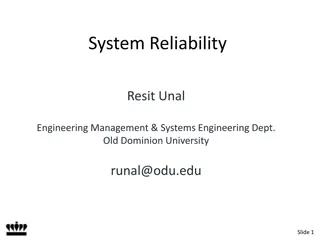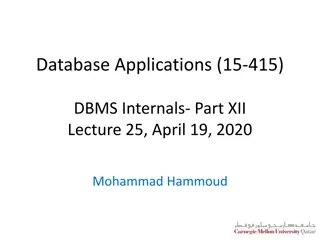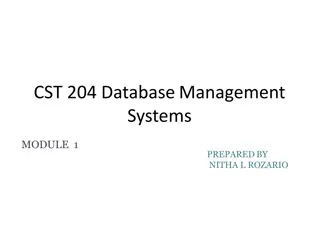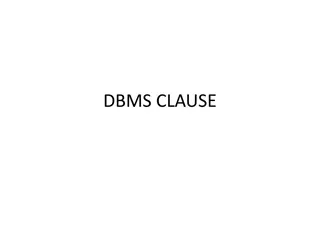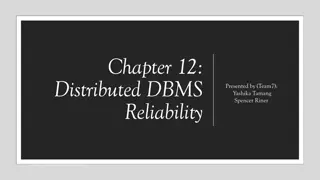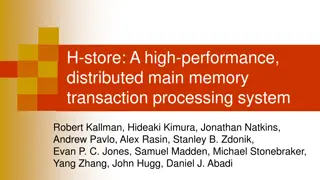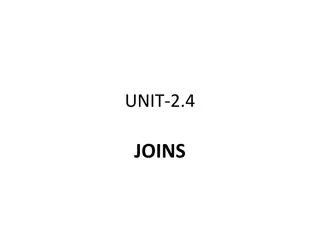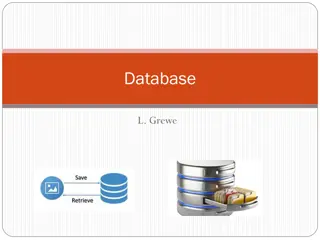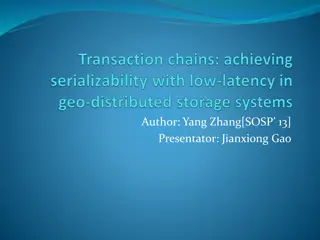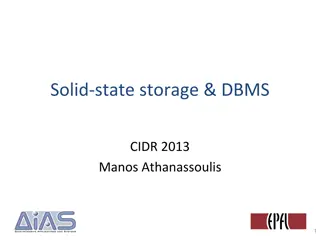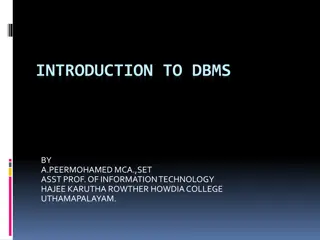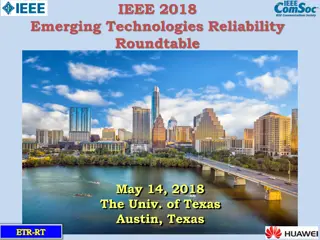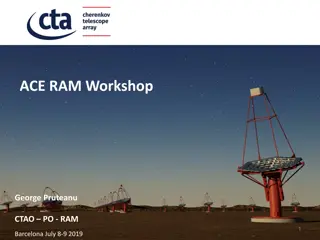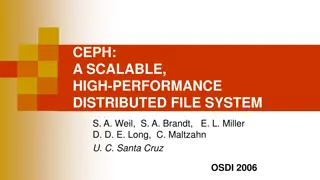Distributed DBMS Reliability Concepts and Measures
Distributed DBMS reliability is crucial for ensuring continuous user request processing despite system failures. This chapter delves into fundamental definitions, fault classifications, and types of faults like hard and soft failures in distributed systems. Understanding reliability concepts helps in designing robust distributed database management systems.
Download Presentation

Please find below an Image/Link to download the presentation.
The content on the website is provided AS IS for your information and personal use only. It may not be sold, licensed, or shared on other websites without obtaining consent from the author.If you encounter any issues during the download, it is possible that the publisher has removed the file from their server.
You are allowed to download the files provided on this website for personal or commercial use, subject to the condition that they are used lawfully. All files are the property of their respective owners.
The content on the website is provided AS IS for your information and personal use only. It may not be sold, licensed, or shared on other websites without obtaining consent from the author.
E N D
Presentation Transcript
Chapter 12: Distributed DBMS Reliability Presented by (Team7): Yashika Tamang Spencer Riner 1
Outline 12.0 Reliability 12.1 Reliability concepts and measures 12.2 Failures in Distributed DBMS 12.3. Local Reliability Protocol 12.4. Distributed Reliability Protocols 12.5. Dealing with site failures 12.6 Network Partitioning 12.7 Architectural Considerations 12.8 Conclusion 12.9 Class Exercise CSCI 5533:Distributed Information System Chapter 12: Distributed DBMS Reliability 2
12.0 Reliability A reliable DDBMS is one that can continue to process user requests even when the underlying system is unreliable, i.e., failures occur. Data replication + Easy scaling = Reliable system Distribution enhances system reliability (not enough). Need number of protocols to be implemented to exploit distribution and replication. Reliability is closely related to the problem of how to maintain the atomicity and durability properties of transactions. CSCI 5533:Distributed Information System Chapter 12: Distributed DBMS Reliability 3
12.1 Reliability Concepts and Measures Fundamental Definitions 12.1.1 System, State and Failure Reliability refers to a system that consists of a set of components. The system has a state, which changes as the system operates. The behavior of the system : authoritative specification indicates the valid behavior of each system state. Any deviation of a system from the behavior described in the specification is considered a failure. In an unreliable system, it is possible that the system may get to an internal state that may not obey its specification., is called erroneous state. The part of the state which is incorrect is an error. An error in the internal states of the components of a system or in the design of a system is a fault. CSCI 5533:Distributed Information System Chapter 12: Distributed DBMS Reliability 4
12.1 Reliability Concepts and Measures (contd..) Faults to error causes results in Fault Error Failure CSCI 5533:Distributed Information System Chapter 12: Distributed DBMS Reliability 5
12.1 Reliability Concepts and Measures (contd..) Types of faults Hard faults Permanent Resulting failures are called hard failures Soft faults Transient or intermittent Account for more than 90% of all failures Resulting failures are called soft failures CSCI 5533:Distributed Information System Chapter 12: Distributed DBMS Reliability 6
12.1 Reliability Concepts and Measures (contd..) Classification of Faults Permanent fault Permanent error Incorrect design Unstable or marginal components System Failure Intermittent error Unstable environment Transient error Operator mistake CSCI 5533:Distributed Information System Chapter 12: Distributed DBMS Reliability 7
12.1 Reliability Concepts and Measures (contd..) Fault tolerant measures 12.1.2 Reliability and Availability Reliability: A measure of success with which a system conforms to some authoritative specification of its behavior. Probability that the system has not experienced any failures within a given time period. Availability: The fraction of the time that a system meets its specification. The probability that the system is operational at a given time t. CSCI 5533:Distributed Information System Chapter 12: Distributed DBMS Reliability 8
12.1 Reliability Concepts and Measures (contd..) The reliability of a system, R(t) = Pr {0 failures in time [0,t] | no failures at t=0} If occurrence of failures follow Poisson distribution, R(t) = Pr {0 failures in time [0,t]} Then where z(x) is known as the hazard function which gives the time-dependent failure rate of the component CSCI 5533:Distributed Information System Chapter 12: Distributed DBMS Reliability 9
12.1 Reliability Concepts and Measures (contd..) The mean number of failures in time [0, t] can be computed as and the variance can be be computed as Thus, reliability of a single component is and of a system consisting of n non-redundant components as CSCI 5533:Distributed Information System Chapter 12: Distributed DBMS Reliability 10
12.1 Reliability Concepts and Measures (contd..) Availability, A(t), refers to the probability that the system is operational according to its specification at a given point in time t. Several failures may have occurred prior to time t, but if they have all been repaired, the system is available at time t. Availability refers to the systems that can be repaired Assumptions: Poisson failures with rate Repair time is exponentially distributed with mean 1/ Then, steady-state availability CSCI 5533:Distributed Information System Chapter 12: Distributed DBMS Reliability 11
12.1 Reliability Concepts and Measures (contd..) o12.1.3 Mean time between Failures/Mean time to Repair o MTBF Mean Time Between Failures o MTTR Mean Time To Repair oUsing these two metrics, the steady-state availability of a system with exponential failure and repair rates can be specified as CSCI 5533:Distributed Information System Chapter 12: Distributed DBMS Reliability 12
12.1 Reliability Concepts and Measures (contd..) System failures may be latent, in that a failure is typically detected sometime after its occurrence. This period is called error latency, and the average error latency time over several identical systems is called mean time to detect (MTTD). CSCI 5533:Distributed Information System Chapter 12: Distributed DBMS Reliability 13
12.2 Failures in Distributed DBMS Types of Failures Transaction failures Reasons : error in the transaction, potential deadlock etc. Approach to handle such failures is to abort the transaction. Site (system) failures Reasons : Hardware or software failures Results in loss of main memory, processor failure or power supply, failed site becomes unreachable from other sites Total failure and partial failure CSCI 5533:Distributed Information System Chapter 12: Distributed DBMS Reliability 14
12.2 Failures in Distributed DBMS (contd..) Media (disk) failures Reasons : operating system errors, hardware, faults such as head crashes or controller failures Refers to the secondary storage device that stores the database. Results in either all or part of the database being inaccessible or destroyed. Communication failures Types: lost (or undeliverable) messages, and communication line failures Network partitioning If the network is partitioned, the sites in each partition may continue to operate. executing transactions that access data stored in multiple partitions becomes a major issue. CSCI 5533:Distributed Information System Chapter 12: Distributed DBMS Reliability 15
12.3 Local Reliability Protocols Functions of LRM LRM (Local Recovery Manager) The execution of the commands such as begin_transaction, read, write, commit and abort to maintain the atomicity and durability properties of the transactions. 12.3.1 Architectural considerations Volatile storage Consists of the main memory of the computer system (RAM). The database kept in volatile storage is volatile database. Stable storage Database is permanently stored in the secondary storage. Resilient to failures, hence less frequent failures. The database kept in stable storage is stable database. CSCI 5533:Distributed Information System Chapter 12: Distributed DBMS Reliability 16
12.3 Local Reliability Protocols (contd..) Main Memory Secondary storage Local Recovery Manager Fetch, Flush Volatile Database Stable Database Write Read Write Database Buffer Manager Read Fig. 12.4 Interface Between the Local Recovery Manager and the Buffer Manager CSCI 5533:Distributed Information System Chapter 12: Distributed DBMS Reliability 17
12.3 Local Reliability Protocols (contd..) 12.3.2 Recovery Information When a system failure occurs, the volatile database is lost. DBMS must maintain some information about its state at the time of the failure to be able to bring the database to the state that it was in when the failure occurred. Recovery information depends on methods of execution updates: In-place updating Physically changes the value of the data item in the stable database, as a result previous values are lost Out-of-place updating Does not change the value of the data item in the stable database but maintains the new value separately CSCI 5533:Distributed Information System Chapter 12: Distributed DBMS Reliability 18
Logging Database Log Every action of a transaction must not only perform the action but must also write a log record to an append-only file. The log contains information used by the recovery process to restore the consistency of a system. Each log record describes a significant event during transaction processing. Types of log records: <Ti, start> : if transaction Ti has started <Ti,Xj,V1,V2>: before Ti executes a write(Xj),where V1 is the old value before write and V2 is the new values after the write <Ti, commit>: if Ti has committed <Ti, abort>: if Ti has aborted <checkpoint> CSCI 5533:Distributed Information System Chapter 12: Distributed DBMS Reliability 19
Why Logging? Upon recovery: all of T1's effects should be reflected in the database (REDO if necessary due to a failure) none of T2's effects should be reflected in the database (UNDO if necessary) crash T1 End Begin Begin T2 t time 0 CSCI 5533:Distributed Information System Chapter 12: Distributed DBMS Reliability 20
In-place update recovery information Old stable database Update information New stable database Database log Fig. 12.5 Update Operation Execution CSCI 5533:Distributed Information System Chapter 12: Distributed DBMS Reliability 21
In-place update recovery information (contd..) Old stable database state New stable database state REDO Database log Fig. 12.6 REDO action CSCI 5533:Distributed Information System Chapter 12: Distributed DBMS Reliability 22
In-place update recovery information (contd..) New stable database state Old stable database state UNDO Database log Fig. 12.7 UNDO action CSCI 5533:Distributed Information System Chapter 12: Distributed DBMS Reliability 23
Example for in-place update Example: Consider the transactions T0 and T1 (T0 executes before T1) and the following initial values: A=1000, B=2000, and C=700 T0: Possible order of actual outputs to the log file and the DB: Read(A) A=A-50 Write(A) Read(B) B=B+50 Write(B) Log DB <T0,start> <T0,A,1000,950> <T0,B,2000,2050> <T0,commit> A=950 B=2050 T1: Read(C) C=C-100 Write(C) <T1,start> <T1,C,700,600> <T1,commit> C=600 CSCI 5533:Distributed Information System Chapter 12: Distributed DBMS Reliability 24
Example continued.. Consider the log after some system crashes and the corresponding recovery actions (c) <T0,start> <T0,A,1000,950> <T0,B,2000,2050> <T0,commit> <T1,start> <T1,C,700,600) <T1,commit> (b) <T0,start> <T0,A,1000,950> <T0,B,2000,2050> <T0,commit> <T1,start> <T1,C,700,600) (a) <T0,start> <T0,A,1000,950> <T0,B,2000,2050> (a). undo(T0): B is restored to 2000 and A to 1000 (b). Undo(T1) and redo(T0): C is restored to 700, and then A and B are set to 950 and 2050, respectively (c). Redo(T0) and redo (T1): And B are set to 950 and 2050, respectively; then C is set to 600 CSCI 5533:Distributed Information System Chapter 12: Distributed DBMS Reliability 25
When to write log records into the stable store? Assume a transaction T updates a page P Fortunate case System writes P in stable database System updates stable log for this update SYSTEM FAILURE OCCURS!... (before T commits) We can recover (undo) by restoring P to its old state by using the log Unfortunate case System writes P in stable database SYSTEM FAILURE OCCURS!... (before stable log is updated) We cannot recover from this failure because there is no log record to restore the old value. Solution: Write-Ahead Log (WAL) protocol CSCI 5533:Distributed Information System Chapter 12: Distributed DBMS Reliability 26
Write-Ahead Log protocol WAL protocol : Before a stable database is updated, the undo portion of the log should be written to the stable log. When a transaction commits, the redo portion of the log must be written to stable log prior to the updating of the stable database. Notice: If a system crashes before a transaction is committed, then all the operations must be undone. Only need the before images (undo portion of the log). Once a transaction is committed, some of its actions might have to be redone. Need the after images (redo portion of the log). CSCI 5533:Distributed Information System Chapter 12: Distributed DBMS Reliability 27
Out-of-place update recovery information Techniques for out-of-place recovery Shadowing When an update occurs, don't change the old page, but create a shadow page with the new values and write it into the stable database. Update the access paths so that subsequent accesses are to the new shadow page. The old page retained for recovery. Differential files For each file F maintain a read only part FR a differential file consisting of insertions part DF+ and deletions part DF- Thus, F = (FR DF+) DF- Updates treated as delete old value, insert new value CSCI 5533:Distributed Information System Chapter 12: Distributed DBMS Reliability 28
Execution strategies Dependent upon Can the buffer manager decide to write some of the buffer pages being accessed by a transaction into stable storage or does it wait for LRM to instruct it? fix/no-fix decision Does the LRM force the buffer manager to write certain buffer pages into stable database at the end of a transaction's execution? flush/no-flush decision Possible execution strategies: no-fix/no-flush no-fix/flush fix/no-flush fix/flush CSCI 5533:Distributed Information System Chapter 12: Distributed DBMS Reliability 29
No-fix/No-flush This type of LRM algorithm is called a redo/undo algorithm since it requires performing both the redo and undo operations upon recovery. Abort Buffer manager may have written some of the updated pages into stable database LRM performs transaction undo (or partial undo) Commit LRM writes an end_of_transaction record into the log. Recover For those transactions that have both a begin_transaction and an end_of_transaction record in the log, a partial redo is initiated by LRM For those transactions that only have a begin_transaction in the log, a global undo is executed by LRM CSCI 5533:Distributed Information System Chapter 12: Distributed DBMS Reliability 30
No-fix/flush The LRM algorithms that use this strategy are called undo/no-redo. Abort Buffer manager may have written some of the updated pages into stable database LRM performs transaction undo (or partial undo) Commit LRM issues a flush command to the buffer manager for all updated pages LRM writes an end_of_transaction record into the log. Recover No need to perform redo Perform global undo CSCI 5533:Distributed Information System Chapter 12: Distributed DBMS Reliability 31
Fix/No-Flush In this case the LRM controls the writing of the volatile database pages into stable storage. This precludes the need for a global undo operation and is therefore called a redo/no-undo. Abort None of the updated pages have been written into stable database Release the fixed pages Commit LRM writes an end_of_transaction record into the log. LRM sends an unfix command to the buffer manager for all pages that were previously fixed Recover Perform partial redo No need to perform global undo CSCI 5533:Distributed Information System Chapter 12: Distributed DBMS Reliability 32
Fix/Flush This is the case where the LRM forces the buffer manager to write the updated volatile database pages into the stable database at precisely the commit point not before and not after. This strategy is called no-undo/no-redo. Abort None of the updated pages have been written into stable database Release the fixed pages Commit (the following must be done atomically) LRM issues a flush command to the buffer manager for all updated pages LRM sends an unfix command to the buffer manager for all pages that were previously fixed LRM writes an end_of_transaction record into the log. Recover No need to do anything CSCI 5533:Distributed Information System Chapter 12: Distributed DBMS Reliability 33
12.3 Local Reliability Protocols 12.3.4 Checkpointing Process of building a "wall" that signifies the database is up-to-date and consistent Achieved in three steps: Write a begin_checkpoint record into the log Collect the checkpoint data into the stable storage Write an end_checkpoint record into the log First and third steps ensure atomicity Different alternatives for Step 2 Transaction-consistent checkpointing incurs a significant delay Alternatives: action-consistent checkpoints, fuzzy checkpoints CSCI 5533:Distributed Information System Chapter 12: Distributed DBMS Reliability 34
12.3 Local Reliability Protocols 12.3.5 Handling Media Failures May be catastrophic or result in partial loss Maintain an archive copy of the database and the log on a different storage medium Typically magnetic tape or CD-ROM Three levels of media hierarchy: main memory, random access disk storage, magnetic tape When media failure occurs, database is recovered by redoing and undoing transactions as stored in the archive log How is the archive database stored? Perform archiving concurrent with normal processing Archive database incrementally so that each version contains changes since last archive CSCI 5533:Distributed Information System Chapter 12: Distributed DBMS Reliability 35
12.4 Distributed Reliability Protocols Protocols address the distributed execution of the begin_transaction, read, write, abort, commit, and recover commands Execution of the begin_transaction, read, and write commands does not cause significant problems Begin_transaction is executed in same manner as centralized case by transaction manager Abort is executed by undoing its effects Common implementation for distributed reliability protocols Assume there is a coordinator process at the originating site of a transaction At each site where the transaction executes there are participant processes Distributed reliability protocols are implemented between coordinator and participants CSCI 5533:Distributed Information System Chapter 12: Distributed DBMS Reliability 36
12.4 Distributed Reliability Protocols 12.4.1 Components of Distributed Reliability Protocols Reliability techniques consist of commit, termination, and recovery protocols Commit and recover commands executed differently in a distributed DBMS than centralized Termination protocols are unique to distributed systems Termination vs. recovery protocols Opposite faces of recovery problem Given a site failure, termination protocols address how the operational sites deal with the failure Recovery protocols address procedure the process at the failed site must go through to recover its state Commit protocols must maintain atomicity of distributed transactions Ideally recovery protocols are independent no need to consult other sites to terminate transaction CSCI 5533:Distributed Information System Chapter 12: Distributed DBMS Reliability 37
12.4 Distributed Reliability Protocols 12.4.2 Two-Phase Commit Protocol Insists that all sites involved in the execution of a distributed transaction agree to commit the transaction before its effects are made permanent Scheduler issues, deadlocks necessitate synchronization Global commit rule: If even one participant votes to abort the transaction, the coordinator must reach a global abort decision If all the participants vote to commit the transaction, the coordinator must reach a global commit decision A participant may unilaterally abort a transaction until an affirmative vote is registered A participant's vote cannot be changed Timers used to exit from wait states CSCI 5533:Distributed Information System Chapter 12: Distributed DBMS Reliability 38
CSCI 5533:Distributed Information System Chapter 12: Distributed DBMS Reliability 39
CSCI 5533:Distributed Information System Chapter 12: Distributed DBMS Reliability 40
12.4 Distributed Reliability Protocols 12.4.2 Two-Phase Commit Protocol Centralized vs. Linear/nested 2PC Centralized participants do not communicate among themselves Linear participants can communicate with one another Sites in linear system become numbered, pass messages to one another with "vote-commit" or "vote- abort" messages If last node decides to commit, send message back to coordinator node-by-node Distributed 2PC eliminates second phase of linear protocol Coordinator sends Prepare message to all participants Each participant sends its decision to all other participants and coordinator Participants must know identity of other participants for linear and distributed, not centralized CSCI 5533:Distributed Information System Chapter 12: Distributed DBMS Reliability 41
CSCI 5533:Distributed Information System Chapter 12: Distributed DBMS Reliability 42
12.4 Distributed Reliability Protocols 12.4.3 Variations of 2PC Presumed Abort 2PC Protocol Participant polls coordinator and there is no information about transaction, aborts Coordinator can forget about transaction immediately after aborting Expected to be more efficient, saves message transmission between coordinator and participants Presumed Commit 2PC Protocol Likewise, if no information about transaction exists, should be considered committed Most transactions are expected to commit Could cause inconsistency must create a collecting record CSCI 5533:Distributed Information System Chapter 12: Distributed DBMS Reliability 43
12.5 Dealing with Site Failures 12.5.1 Termination and Recovery Protocols for 2PC Termination Protocols Coordinator Timeouts Timeout in the WAIT state coordinator can globally abort transaction, cannot commit Timeout in the COMMIT or ABORT states Coordinator sends "global-commit" or "global-abort" commands Participant Timeouts Timeout in the INITIAL state Coordinator must have failed in the INITIAL state Timeout in the READY state Has voted to commit, does not know global decision of coordinator CSCI 5533:Distributed Information System Chapter 12: Distributed DBMS Reliability 44
12.5 Dealing with Site Failures 12.5.1 Termination and Recovery Protocols for 2PC Recovery Protocols Coordinator Site Failures Coordinator fails while in the INITIAL state Starts commit process upon recovery Coordinator fails while in the WAIT state Coordinator restarts commit process for transaction by sending prepare message Coordinator fails while in the COMMIT or ABORT states Does not need to act upon recovery (participants informed) Participant Site Failures Participant fails in the INITIAL state Upon recovery, participant should abort unilaterally Participant fails while in the READY state Can treat as timeout in the READY state, hand to termination Participant fails while in the ABORT or COMMIT state Participant takes no special action CSCI 5533:Distributed Information System Chapter 12: Distributed DBMS Reliability 45
12.5 Dealing with Site Failures 12.5.2 Three-Phase Commit Protocol Designed as a non-blocking protocol To be non-blocking, state transition diagram must contain neither of the following: No state that is "adjacent" to both a commit and an abort state No non-committable state that is "adjacent" to a commit state Adjacency refers to ability to go from one state to another with a single transition To make 2PC non-blocking, add another state between WAIT/READY and COMMIT states that serves as a buffer Three phases: INITIAL to WAIT/READY WAIT/READY to ABORT or PRECOMMIT PRECOMMIT to COMMIT CSCI 5533:Distributed Information System Chapter 12: Distributed DBMS Reliability 46
CSCI 5533:Distributed Information System Chapter 12: Distributed DBMS Reliability 47
CSCI 5533:Distributed Information System Chapter 12: Distributed DBMS Reliability 48
12.5 Dealing with Site Failures 12.5.2 Termination and Recovery Protocols for 3PC Termination Protocols Coordinator Timeouts Timeout in the WAIT state coordinator can globally abort transaction, cannot commit Timeout in the PRECOMMIT state Coordinator sends prepare-to-commit message, globally commits to operational participants Timeout in the COMMIT or ABORT states Can follow termination protocol Participant Timeouts Timeout in the INITIAL state Coordinator must have failed in the INITIAL state Timeout in the READY state Has voted to commit, elects new coordinator Timeout in the PRECOMMIT state Handled identically to timeout in READY state CSCI 5533:Distributed Information System Chapter 12: Distributed DBMS Reliability 49
12.5 Dealing with Site Failures 12.5.1 Termination and Recovery Protocols for 2PC Recovery Protocols Coordinator Site Failures Coordinator fails while in the INITIAL state Starts commit process upon recovery Coordinator fails while in the WAIT state Coordinator restarts commit process for transaction by sending prepare message Coordinator fails while in the COMMIT or ABORT states Does not need to act upon recovery (participants informed) Participant Site Failures Participant fails in the INITIAL state Upon recovery, participant should abort unilaterally Participant fails while in the READY state Can treat as timeout in the READY state, hand to termination Participant fails while in the ABORT or COMMIT state Participant takes no special action CSCI 5533:Distributed Information System Chapter 12: Distributed DBMS Reliability 50



